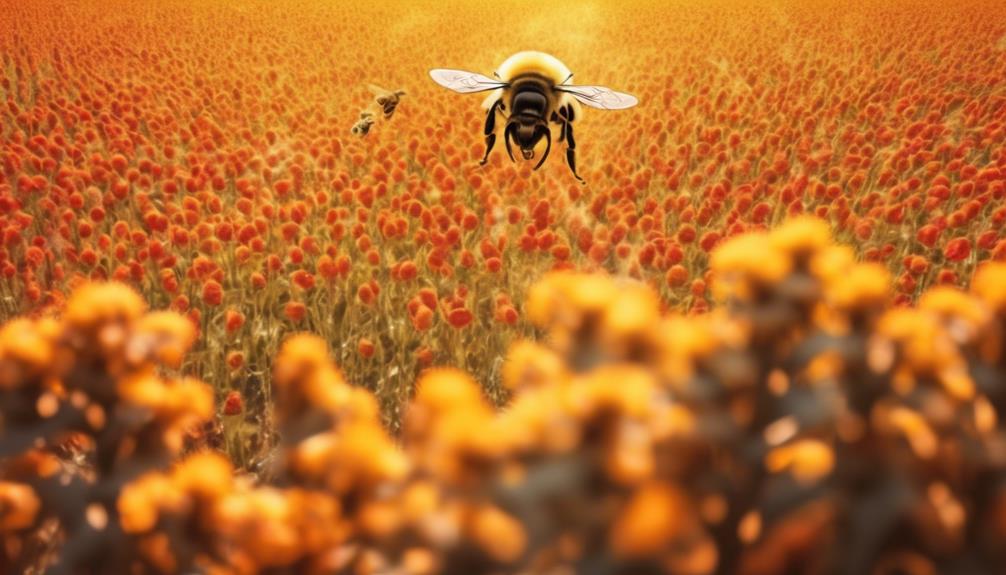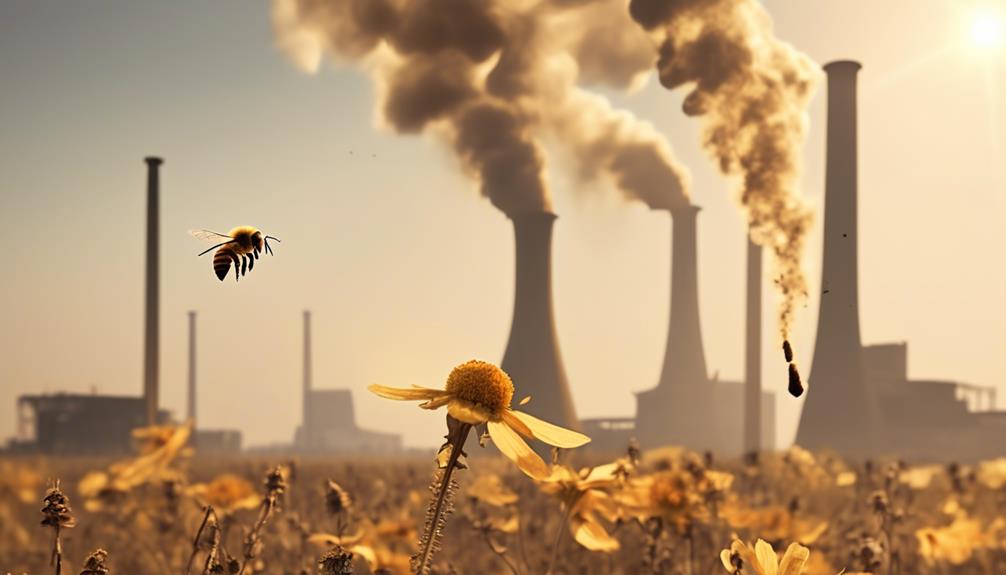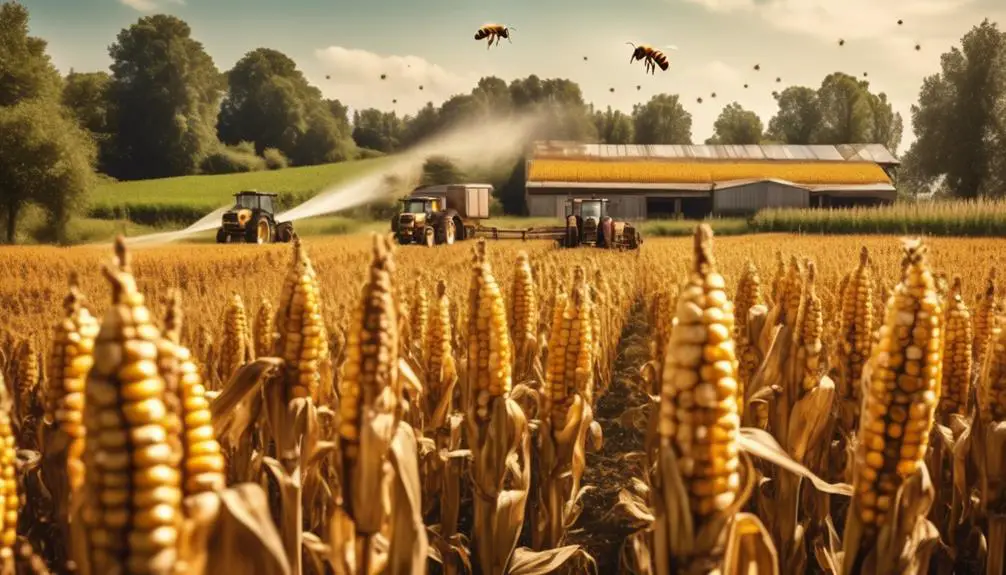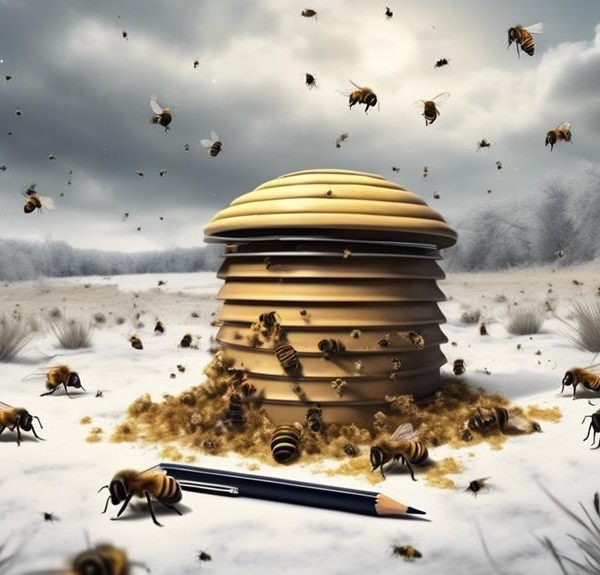Journey into the reasons behind the alarming extinction of bees, crucial pollinators whose decline threatens our food supply and ecological balance.

What Are Reasons Why Bees Are Starting to Go Extinct
Like a canary in a coal mine, the global decline of bees signals a serious red flag for our own survival. You might wonder, 'What's the big deal about little bees?' Yet, these tiny insects are the workhorses of our food supply, responsible for pollinating about 70 of the 100 crop species that feed 90% of the world.
You might find it alarming to learn that bees are starting to go extinct. A myriad of reasons, ranging from climate change to the use of pesticides, parasites, diseases, habitat loss, and the effects of industrial agriculture, are making them buzz their last.
So, why is the bee population dwindling, and what does this mean for our future? Let's venture into this intriguing topic.
Key Takeaways
- Pesticides, particularly neonicotinoids, are a significant threat to bee survival, harming their central nervous system and reproductive abilities.
- Climate change is disrupting the synchronization between bees and flowering plants, destroying their habitats, and increasing the spread of parasites and diseases.
- Bees are falling victim to various deadly illnesses, such as the Varroa mite and American Foulbrood, with pesticides weakening their immune system.
- Habitat loss and fragmentation due to urbanization are reducing space and food sources for bee colonies, isolating populations and increasing vulnerability to extinction.
Pesticides and Their Impact

While it's true that bees are crucial for our ecosystem, you mightn't be aware that widespread use of pesticides is posing a significant threat to their survival. These toxic substances, designed to kill pests, don't discriminate between harmful insects and beneficial ones like bees. When bees come into contact with these chemicals, whether through air, water, or directly on plants, they can suffer immediate harm or long-term damage.
One particular class of pesticides, neonicotinoids, has been particularly harmful. They're neuro-active, meaning they're capable of damaging a bee's central nervous system. This can lead to impaired navigation, disorientation, decreased foraging ability, and ultimately, colony collapse.
You might think that reducing the concentration of these pesticides would solve the problem. However, studies have shown that even at low, 'non-lethal' concentrations, these substances can still have detrimental effects on bees. This includes hindering their ability to reproduce and making them more susceptible to diseases.
It's clear that the usage of pesticides is a complex issue, requiring further scrutiny and regulatory oversight. But it's undeniable that their current use is contributing significantly to the decline of bee populations, putting our entire ecosystem at risk.
The Role of Climate Change

Beyond the impact of pesticides, you can't overlook the role of climate change in the decline of bee populations. Rising temperatures are altering the synchronization between bees and flowering plants. You see, bees rely on the availability of flowers for food. When climate change disrupts the timing of flower blooming, bees can't find the nourishment they need.
Additionally, extreme weather events like droughts and floods, which are becoming more frequent due to climate change, are destroying bee habitats. Bees can't survive if they don't have a suitable place to live and breed.
Furthermore, climate change is amplifying the spread of harmful parasites and diseases among bees. Warmer temperatures are creating more favorable conditions for these pests, accelerating their growth and spread.
Lastly, as you know, bees are crucial for pollination. However, irregular climate patterns are causing early or late plant flowering, which in turn affects bees' pollination schedules and efficiency. This can lead to decreased crop yields, impacting not just bees, but human food supply too.
Consequently, climate change isn't just an environmental issue; it's a significant threat to our food security. Remember, the disappearance of bees isn't just their problem—it's ours too.
Parasites and Diseases

Turning our attention to another critical factor, it's essential to consider how parasites and diseases are severely impacting the survival of bees. It's no secret that these tiny creatures are falling victim to a host of illnesses, many of which are deadly.
The Varroa mite, for instance, is a parasitic creature that attaches itself to the bee, sucking its blood and transmitting viruses. This parasite weakens bees, making them more susceptible to other diseases and reducing their lifespan.
Furthermore, bees are also being hit hard by a bacterial disease known as American Foulbrood. This illness destroys their larvae, putting entire colonies at risk. Pesticides, which bees encounter when pollinating, can also weaken their immune system, leaving them more vulnerable to disease.
Adding to this, the spread of Nosema, a fungal disease, can decimate bee populations by causing severe digestive issues. These problems are compounded by the stress bees endure due to changes in their habitats and climate change.
In the face of these threats, it's imperative that we take steps to protect our bee populations. Without them, the consequences for our planet could be devastating.
Habitat Loss and Fragmentation

Have you ever considered how habitat loss and fragmentation pose significant threats to the survival of bees? As urbanization increases, natural landscapes are replaced with concrete jungles, leading to destruction and fragmentation of habitats that bees rely on for survival.
Habitat loss doesn't only mean less space for bee colonies; it also means a decrease in the variety and abundance of flora that bees depend on for nectar and pollen, their primary food sources. Furthermore, fragmentation of habitats can isolate bee populations, obstructing their gene flow and increasing their vulnerability to extinction.
Pesticides used in agriculture and gardening can contaminate these fragmented habitats, posing additional threats. These chemicals can disrupt bees' foraging behavior, breeding, and immunity, exacerbating their decline.
When you're tending to your garden or supporting urban development, it's crucial to consider its potential impact on bees. Preserving natural habitats, planting diverse flora, and reducing pesticide use can help mitigate these threats.
Effects of Industrial Agriculture

Industrial agriculture's relentless march, with its heavy reliance on monoculture crops and synthetic pesticides, is wreaking havoc on bee populations worldwide.
You see, monocultures, vast stretches of a single crop, eliminate the diverse food sources that bees need for survival. When bees can't find a variety of pollen and nectar sources, their diet becomes nutritionally deficient, compromising their health and resilience.
Synthetic pesticides, particularly neonicotinoids, are another major culprit. They're neurotoxic to bees, impairing their ability to navigate and forage. Worse, they can persist in the environment, getting into pollen and nectar, and eventually harming entire bee colonies. It's a grim scenario, but it's what's happening.
But it's not just about the bees. You should understand that bees play a crucial role in pollination, which is vital for food production. When bees decline, crop yields can suffer, threatening our food security. So, the effect of industrial agriculture on bees isn't just an ecological issue—it's a socio-economic one too.
Frequently Asked Questions
How Does the Extinction of Bees Affect the Global Economy?"
Bees' extinction can hit your wallet hard. They're vital for pollination, impacting the production of foods you consume daily. With fewer bees, crop yields drop, raising food prices.
Additionally, industries relying on bee-pollinated plants suffer. Imagine your favorite fruits, vegetables, or nuts becoming luxury items. That's a potential reality without bees.
Plus, the increased costs of manual pollination could further burden economies. So, the bee crisis isn't simply an environmental issue, but a financial one too.
What Are the Potential Solutions Being Explored to Prevent Bee Extinction?"
You're probably wondering about solutions to prevent bee extinction. They're being explored on multiple fronts.
Renewed agricultural practices are crucial, reducing pesticide use and cultivating bee-friendly landscapes.
Meanwhile, scientists are studying bees' genetics, seeking traits for pesticide resistance and disease resilience.
Beekeeping practices are also under review, with a focus on hive health.
Lastly, public education campaigns aim to raise awareness about the bees' plight and how individuals can help.
Are There Any Specific Bee Species More at Risk of Extinction Than Others?"
Yes, certain bee species are more at risk than others. For example, the Rusty Patched Bumble Bee and Hawaiian Yellow-faced bees are critically endangered. Factors like habitat loss, climate change, and pesticide use hit them harder.
You'd be surprised to know that the survival of these bees greatly influences the biodiversity of our ecosystem. So, it's not just about saving the bees, it's also about preserving the balance of our environment.
How Do Bees Contribute to the Biodiversity of an Ecosystem?"
Bees are crucial to ecosystem biodiversity. They're key pollinators, transferring pollen and seeds from one flower to another, enabling plant reproduction. Without bees, many plants would struggle to reproduce, which would affect the entire food chain.
They also help to grow many of the fruits, vegetables, and nuts we eat. So, if bees were to disappear, it'd dramatically impact our food sources and disrupt the balance of nature.
What Can Individuals Do at a Local Level to Help Prevent Bee Extinction?"
You can make a significant difference in preventing bee extinction locally.
Start by creating a bee-friendly environment in your garden. Planting native flowers, providing fresh water, and avoiding pesticides attracts bees.
Additionally, buying local honey supports beekeepers who ensure bee populations thrive.
Advocacy's also essential. Educate others about the importance of bees and the threats they face.
Conclusion
You've seen how pesticides, climate change, parasites, diseases, habitat loss, and industrial agriculture are putting bees on the brink of extinction.
These aren't just isolated issues; they're interconnected, creating a lethal cocktail for our buzzing friends.
It's clear we need to act urgently and consciously in our interaction with the environment to ensure bees, and in turn our ecosystem, continue to thrive.
After all, their survival hinges on our choices and actions.



